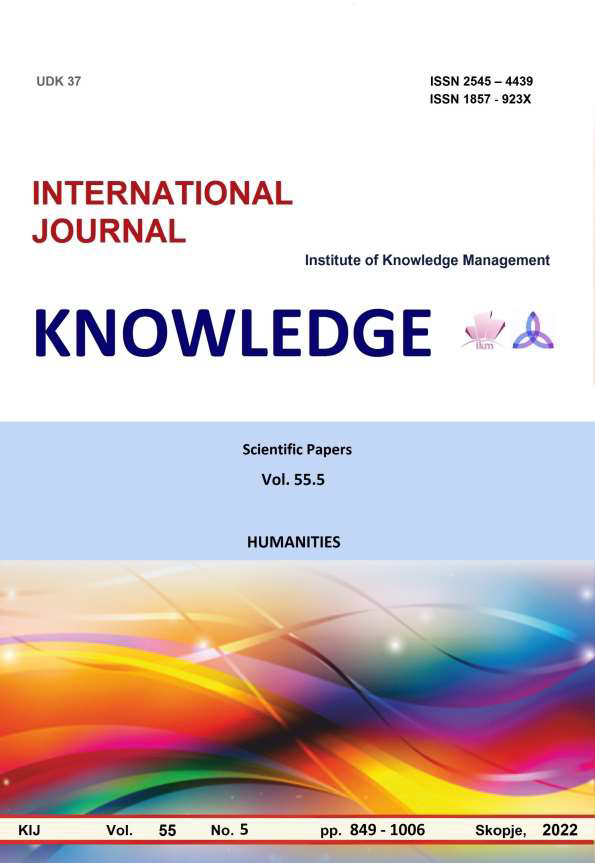ANALYSIS OF THE IMPACT OF SCREEN MEDIA VERSUS LIVE ART ON CHILDREN’S CREATIVITY AND AGGRESSION. THE PAMI METHOD
DOI:
https://doi.org/10.35120/kij5505945sKeywords:
screen, child development, creativity, aggression, art therapyAbstract
In today's environment children are subject to multiple multimedia impacts. From the first months of their
life they are exposed to various screen media and that process accelerates with each successive generation.
Electronic communications affects more actively all spheres of life and increasingly taking precedence over live
interactions between people. The impact of screen media on children's development has been widely discussed.
According to some authors screen technologies open new learning opportunities for children and equip them with
skills and knowledge they will need in the future. Other studies show that increased exposure time to screen
technologies has negative impacts on children's behavior and might provoke cognitive and developmental language
disorders. This project aims to add a new point to the overall view of the impact of screen media versus live creative
interaction on children's creativity and aggression. The experiment was conducted by a team of psychologist, art
and music therapists by using a new Psychological, Art and Music Intervention Method (PAMI). The participants
were 9 children aged 6 to 11 years, users of the social services at the Community Support Centre in Elin Pelin
Municipality. Quantitative and qualitative indicators were used in the data analysis, as well as the observations and
specific expertise of the team that carried out the study. The results have indicated that contact based on art and
active imagination provokes sublimation of aggression, as well as integration of existing conflicts and traumas. In
this hypothesis children tend to express their fears and wishes, make connections and revisions of past traumatic
events in their own unique way. On the other hand, when the interaction is rooted in screen media, the children are
not willing to engage in a dialogue and their personal presence is limited. The children seem absorbed by the screen,
not using their imagination and creativity. The role of passive recipients significantly limits the children’s relation to
themselves and their past traumas, which makes them absent, irritable and passively aggressive. In conclusion, the
findings of the study show that live art promotes creativity and coping with aggression, whereas screen media block
creativity thus leading to increased irritability and aggression in children. The use of the Psychological, Art and
Music Intervention Method (PAMI) might help professionals to identify quickly and non-traumatically the problem
areas in children’s lives and opens up new opportunities to work with their trauma and fears. The method can be
successfully use for diagnosis and assessment in both individual and group work. We hope that this study will lay
the foundations for future research in the field
References
Anderson, D., & Subrahmanyam, K. (2017). Digital Screen Media and Cognitive Development, Pediatrics 140
(Supplement 2), 57–61. https://doi.org/10.1542/peds.2016-1758C
Domingues-Montanari, S. (2017). Clinical and psychological effects of excessive screen time on children. Journal of Pediatric and Child Health, Volume53, Issue4, 333-338. https://doi.org/10.1111/jpc.13462
Green, C., & Bavelier, D. (2003). Action video game modifies visual selective attention. Nature 423, 534–537. https://doi.org/10.1038/nature01647
Green, C., Li, R., & Bavelier, D. (2010). Perceptual learning during action video game playing. Topics in Cognitive Science. Apr;2(2):202-16. https://doi.org/10.1111/j.1756-8765.2009.01054.x
Kirkorian, H. (2018). When and How Do Interactive Digital Media Help Children Connect What They See On and Off the Screen? Volume12, Issue3, 210-214. https://doi.org/10.1111/cdep.12290
Kara, H. (2018). A Case Study on Reducing Children’s Screen Time: The Project of Screen Free Week. World Journal of Education Vol. 8, No. 1, 100-110. https://doi.org/10.5430/wje.v8n1p100
Kashapov, M., Ogorodova Т., & Pavlova, S. (2016). Relationship between Aggression and Creativity in Senior Preschool Children. Procedia - Social and Behavioral Sciences, Vol. 233, 264-268. https://doi.org/10.1016/j.sbspro.2016.10.121
Martzog, P., & Suggate, S. (2022). Screen media are associated with fine motor skill development in preschool children. Early Childhood Research Quarterly,Volume 60, 363-373. https://doi.org/10.1016/j.ecresq.2022.03.010.
Suggate, S., & Martzog, P. (2021). Children's sensorimotor development in relation to screen-media usage: A two-year longitudinal study. Journal of Applied Developmental Psychology,Volume 74, 101279. https://doi.org/10.1016/j.appdev.2021.101279
Wan, M., Fitch-Bunce, C., Heron, K., & Lester, E. (2021). Infant screen media usage and social-emotional functioning. Infant Behavior and Development,Volume 62. https://doi.org/10.1016/j.infbeh.2020.101509
Стаматов, Р. (2015). Креативността. Пловдив, България, Университетско издателство, Паисий Хилендарски“.





